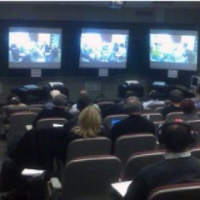Trial Presentation Customized Solutions for Captivating Legal Presentations
Trial Presentation Customized Solutions for Captivating Legal Presentations
Blog Article
Astound the Court: Vital Elements of a Powerful Trial Discussion
Important components such as recognizing the target market, crafting an engaging narrative, and understanding verbal and non-verbal communication are crucial elements of an effective presentation. As these aspects link, they create a natural strategy that not just informs yet also involves jurors on numerous levels.

Understanding Your Audience
Comprehending your audience is an essential element of efficient trial presentation. A successful discussion depends upon the ability to grasp the demographics, values, and tendencies of jurors. This comprehension notifies exactly how disagreements are mounted, proof exists, and psychological charms are crafted, making sure that the message reverberates with the jurors on a personal level.
Study suggests that jurors come from diverse histories and may have differing degrees of comprehending pertaining to lawful procedures. Additionally, comprehending the jurors' potential prejudices and life experiences allows the test speaker to expect objections and address problems proactively.
Effective trial presentation additionally entails observing jurors' responses during the process. Involving with jurors as individuals instead than a cumulative unit is important in promoting a strong connection in the courtroom.

Crafting an Engaging Story
Crafting an engaging narrative is essential in leading jurors via the complexities of an instance. A well-structured story not only streamlines complex lawful concepts yet additionally engages jurors on an emotional degree, making the details extra relatable and remarkable.
This message should resonate with the jurors' values and experiences, fostering a connection that transcends simple realities. This chronological strategy can aid jurors follow the progression of occasions, stressing reason and effect.
Integrating human components-- such as personal tales or stories-- can even more enhance the narrative's influence. These aspects stimulate compassion, enabling jurors to visualize the repercussions of the instance on real lives. In addition, utilizing a consistent style throughout the presentation enhances the major disagreement, making it less complicated for jurors to preserve crucial points.
Inevitably, an engaging narrative transforms a test presentation from a mere recounting of truths right into a convincing tale that astounds the jury, motivating them to mull over with both factor and emotion.
Using Visual Help
Integrating aesthetic help into a trial discussion can significantly improve jurors' understanding and retention of details. Aesthetic materials such as charts, diagrams, photos, and videos can change intricate legal ideas and proof into conveniently digestible layouts. By engaging numerous detects, these aids enable jurors to picture the case's crucial elements, making it easier for them to comply with along and comprehend elaborate details.
Additionally, properly designed visual aids can emphasize crucial points and emphasize relationships between various pieces of evidence. For example, timelines can effectively show the series of occasions, while annotated photos can make clear specific information appropriate to the case. This not only aids in understanding however also strengthens the narrative offered by the attorney.
Extremely intricate or cluttered visuals may bewilder jurors and Your Domain Name detract from the message. Inevitably, reliable visual interaction can be a powerful device in encouraging jurors and helping them reach notified final thoughts.
Mastering Verbal Communication
Efficient spoken communication is critical in a trial discussion, as it acts as the main means whereby attorneys communicate their disagreements and get in touch with jurors. Mastering this skill includes clarity, persuasion, and involvement. Lawyers must express their points clearly and concisely, staying clear of lawful lingo that may puzzle jurors. Simplicity in language cultivates understanding and aids jurors comprehend complex problems presented throughout the test.
Additionally, tone and pacing substantially impact exactly how messages are gotten. A positive tone conveys authority, while appropriate pacing enables jurors to absorb information without feeling overwhelmed. Attorneys need to additionally vary their vocal inflections to emphasize bottom lines and preserve jurors' interest throughout the presentation.
Furthermore, the company of verbal arguments is vital. Structuring the narrative practically and coherently helps jurors adhere to the attorney's line of thinking, making it less complicated for them to maintain important details. Making use of influential methods, such as narration, can also improve the emotional vibration of the disagreements presented, consequently developing a more see this website profound connection with jurors.
Ultimately, grasping spoken interaction not only strengthens a lawyer's case however likewise cultivates trust fund and connection with the jury, dramatically improving the possibilities of a positive decision.

Involving With Body Language
Nonverbal communication plays an important role in trial discussions, usually conveying messages that words alone can not share. Body movement, encompassing gestures, position, faces, and eye get in touch with, considerably influences just how jurors regard the trustworthiness and sincerity of the speaker. A positive position, with shoulders back and an open pose, can infuse count on, while closed-off body language may recommend defensiveness or uncertainty.

Facial expressions should mirror the emotions connected with the case, enhancing the narrative why not check here existing. An honest expression during a touching minute can elicit empathy and reinforce the emotional appeal. Eventually, grasping body movement is vital for efficient trial presentations, as it improves verbal interaction and establishes a compelling presence that reverberates with the court.
Conclusion
Finally, astounding the jury requires a calculated method that includes recognizing the target market, crafting an engaging story, utilizing visual aids, mastering verbal interaction, and engaging with body movement. Each component plays a crucial function in developing an effective trial presentation that resonates with jurors on both emotional and intellectual degrees (trial presentation). By integrating these components successfully, lawyers can substantially enhance their capacity to convince and affect jury decision-making
Report this page